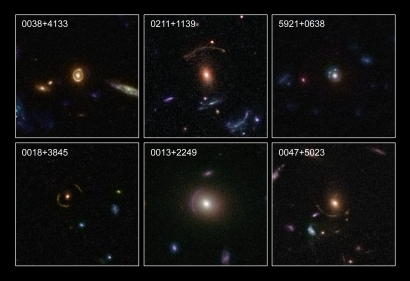Hubble discovers 67 gravitationally lensed galaxies in the distant Universe [heic0806]
19 February 2008
Astronomers using the NASA/ESA Hubble Space Telescope have compiled a large catalogue of galaxy-galaxy lens candidates in the distant Universe. The catalogue contains 67 previously unknown gravitationally lens systems around foreground elliptical and lenticular galaxies. This sample demonstrates the rich diversity of strong gravitational lenses. If this sample is representative, there would be nearly half a million similar gravitational lenses in total over the whole sky.
 |
The lenses come from a recently completed, large set of observations as part of a huge project to survey a single 1.6 square degree field of sky (nine times the area of the full Moon) with several space-based and Earth-based observatories. The COSMOS project, led by Nick Scoville at the California Institute of Technology, USA, used observations from several observatories including the Hubble Space Telescope, as well as the Spitzer Space Telescope, the XMM-Newton spacecraft, the Chandra X-ray Observatory, the Very Large Telescope (VLT), the Subaru Telescope and CFHT.
A team of European astronomers led by Jean-Paul Kneib (Laboratoire d'Astrophysique de Marseille) and Cécile Faure (Zentrum für Astronomie, University of Heidelberg) analysed the results from Hubble’s Advanced Camera for Surveys (ACS). From ACS high-resolution images, complemented by the extensive ground-based follow-up observations, astronomers have identified 67 strong gravitationally lensed galaxies. These were found around very massive galaxies that are usually elliptical or lenticular in shape and often exhibit a paucity of gas and dust without spiral arms or discs. The strong lensing produced by massive galaxies is much more common than the usual giant "arc" gravitationally lensed galaxies that Hubble has previously observed; but they are generally more difficult to find as they extend over a smaller area and have a wide variety of shapes.
Gravitational lensing occurs when light travelling towards us from a distant galaxy is magnified and distorted as it encounters a massive object between the galaxy and us. These gravitational lenses often allow astronomers to peer much further back into the early Universe than normal.
The massive objects that create the lenses are usually huge clusters of massive galaxies. "We typically see the gravitational lens create a series of bright arcs or spots around a galaxy cluster. What we are observing here is a similar effect but on much smaller scale – happening only around a single but very massive galaxy," says Jean-Paul Kneib.
Of the 67 gravitational lenses identified in the COSMOS survey, the most impressive lenses show the distorted and warped light of one or two background galaxies. At least four of the lenses give rise to Einstein rings, a complete circular image of a background galaxy, which is observed when the background galaxy, a massive foreground galaxy and the Hubble Space Telescope are all aligned perfectly.
Hubble astronomers went through a unique process to identify these incredible natural lenses. First, possible galaxies were identified from a galaxy catalogue, comprising more than two million galaxies. "We then had to look through each individual COSMOS image by eye and identify any potential strong gravitational lenses," said Cécile Faure. Finally, checks were made to see if the foreground galaxy and the lensed galaxy were really different or just one galaxy with an odd shape. "With this sample of gravitational systems identified by the human eye, we now plan use the sample of lenses to train robot software to find more of these lenses across the entire Hubble image archive, and we may find even more strong lensing systems in the COSMOS field," added Jean-Paul Kneib.
The new results confirm that the Universe is filled with gravitational lensing systems. Extrapolating these new findings to the whole sky, predicts no less than half a million similar lenses in total. The future prospects for finding more of these systems are thus excellent.
The study of these gravitational lenses will give astronomers a first-rate opportunity to probe the dark matter distribution around galactic lenses. Once astronomers find even larger numbers of these smaller, stronger lenses they can be used to create a census of galaxy masses in the Universe to test predictions from cosmological models.
Notes for editors:
The Hubble Space Telescope is a project of international cooperation between ESA and NASA.
The Space Telescope European Coordinating Facility in Garching near Munich, Germany is responsible for Hubble's grism mode.
Image credit: NASA, ESA, C. Faure (Zentrum für Astronomie, University of Heidelberg) and J.P. Kneib (Laboratoire d’Astrophysique de Marseille)
The research team consists of Cécile Faure (Zentrum Für Astronomie Heidelberg), Jean-Paul Kneib (Laboratoire d’Astrophysique de Marseille & the California Institute of Technology), Giovanni Covone (Laboratoire d’Astrophysique de Marseille & INAF, Osservatorio Astronomico di Capodimonte), Lidia Tasca (Laboratoire d’Astrophysique de Marseille), Alexie Leauthaud (Laboratoire d’Astrophysique de Marseille), Peter Capak (California Institute of Technology), Knud Jahnke11 (Max-Planck-Institut für Astronomie), Vernesa Smolcic (Max-Planck-Institut für Astronomie), Sylvain de la Torre (Laboratoire d’Astrophysique de Marseille), Richard Ellis (California Institute of Technology), Alexis Finoguenov (Max-Planck-Institut für extraterrestrische Physik), Catherine Heymans (Department of Physics & Astronomy, University of British Columbia), Anton Koekemoer (Space Telescope Science Institute), Oliver Le Fevre (Laboratoire d’Astrophysique de Marseille), Richard Massey (California Institute of Technology), Yannick Mellier (Institut d’Astrophysique de Paris), Alexandre Refregier (Service d’Astrophysique, CEA/Saclay), Jason Rhodes (California Institute of Technology), Nick Scoville (California Institute of Technology), Eva Schinnerer (Max-Planck-Institut für Astronomie), James Taylor (California Institute of Technology & Department of Physics and Astronomy, University of Waterloo), Ludovic Van Waerbeke (Department of Physics & Astronomy, University of British Columbia) and Jakob Walcher (Laboratoire d’Astrophysique de Marseille).
Contacts
Cécile Faure
Zentrum für Astronomie Heidelberg, Germany
Tel: +49-1-762-1901-669
Email: cfaure ari.uni-heidelberg.de
ari.uni-heidelberg.de
Jean-Paul Kneib
Laboratoire d’Astrophysique de Marseille, France
Tel: +33-4-91-05-59-13
Mobile: +33-685-988-265
Email: jean-paul.kneib oamp.fr
oamp.fr
Nick Scoville
California Institute of Technology Pasadena, USA
Tel: +1-626-395-4979
E-mail: nzs astro.caltech.edu
astro.caltech.edu
Peter Capak
California Institute of Technology Pasadena, USA
Tel: +1-626-395-6422
E-mail: capak astro.caltech.edu
astro.caltech.edu
Lars Lindberg Christensen
Hubble/ESA, Garching, Germany
Tel: +49-(0)89-3200-6306
Cellular: +49-(0)173-3872-621
E-mail: lars eso.org
eso.org
Ray Villard
Space Telescope Science Institute, Baltimore, USA
Tel: +1-410-338-4514
E-mail: villard stsci.edu
stsci.edu

